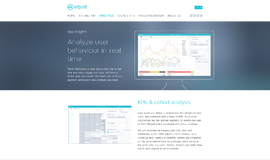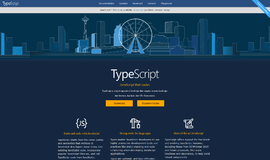Top 5 Mobile App Development Tools
Today it’s easier than ever to build a mobile app. Not only that, but there are several great options for cross-platform development using one code base across iOS, Android, and in some cases other platforms as well. As these technologies mature, stabilize, and grow in popularity, reasons to not use them continually diminish. So let’s take a closer look at some of today’s top cross-platform mobile app development tools.

First on the list is PhoneGap, which probably has the biggest name recognition in the field. It’s the one technology that everybody has heard of and for better or for worse tends to be the one that represents the entire field when developers first think of cross-platform mobile development.
You might be surprised to learn that PhoneGap was purchased from its original creators by Adobe way back in 2011, so it’s no spring chicken. As 2018 rapidly approaches, we can see that PhoneGap has come a long way.
Here’s the gist of it: build a mobile page/app with HTML, CSS, and JavaScript and then “wrap” it all together with PhoneGap. You can then make builds for iOS, Android, and other platforms including Windows Phone, Amazon, and Windows Store. Initially PhoneGap’s target audience was web developers who wanted an easy way to develop mobile apps without learning new technologies and languages. But today, many full fledged mobile developers are turning to it for rapid mobile development. Also, PhoneGap is free.
Of course there are some drawbacks to note. What we end up with is a hybrid mobile app as opposed to a native one. This means performance can really take a hit particularly on graphic intensive apps such as games for example. Also, PhoneGap doesn’t have any built-in UI widgets, controls, etc. So in short, if you’re building an app that is not graphic intensive, doesn’t make significant use of the phone’s native features, and you’re ready to design your own UI, then PhoneGap is a great option to build a mobile app quickly and easily.
BONUS: Check out the new cloud service PhoneGap Build. Upload your HTML5, CSS, and JavaScript to the could, and they’ll take care of the compiling for you. It just keeps getting easier to build mobile apps!

Next up is Ionic, another free and open source platform for cross platform mobile development. Again, use simple web technologies that you’re already likely to be familiar with, but this time include things like AngularJS and TypeScript. Unlike PhoneGap however, Ionic apps are close to native apps both in appearance and performance.
Ionic has a really great looking default UI that is still easy to customize. Forms, tabs, buttons, sliding boxes, and even a cool sliding menu with a very native feel. Also it’s super easy to override styles using SCSS.
Ionic will give you access to native device features like the camera, bluetooth, and even the fingerprint sensor. It’s easy to use and you can take advantage of Ionic CLI (command line interface) to get things done efficiently.
Ionic is built on AngularJS, so if you’re already up to speed with Angular then Ionic will be a great fit. Angular is a bit of a beast though so if you’re new to it there can be a significant learning curve. Keep that in mind before diving into Ionic.

Appcelerator claims that you can “create great, native mobile apps—all from a single JavaScript code base.” That’s mostly true depending on your definition of code base. Sure, with Appcelerator the “base” is the same across platforms, but that doesn’t mean 100% of the code is that same.
In fact is almost certainly won’t be—expect 60% - 90% of the code to be used for both Android and iOS. Still, you’ll get access to native app features using just JavaScript, so this is another option for web developers wanting to break into mobile.
They also offer great support, documentation, and a few value add-ons like user analytics, crash detection, and mobile testing automation. Some of these come at a cost though. Appcelerator has an “Inde” free plan, and a few paid plan options for enterprise. Try it out for free and see if it’s for you.

This JavaScript framework is based on Facebook’s React library and builds real natively rendering Android and iOS apps. So no “hybrid” apps here—React Native apps are “indistinguishable from an app built using Objective-C or Java,” to quote their site. Simple put, React Native compiles the JavaScript you write to native platform specific code.
This gives the framework pretty impressive performance. In fact React Native apps should perform just as well as apps written using Java, Objective-C, or Swift.
One really great benefit is a feature called Hot Reloading. They sum it up nicely:
“The idea behind hot reloading is to keep the app running and to inject new versions of the files that you edited at runtime. This way, you don't lose any of your state which is especially useful if you are tweaking the UI.”
This comes along with great debugging, plenty of third party libraries, great documentation and support, and a large community.
React Native is quite possibly the framework that will become dominant in the coming years as it has a lot going for it. Developers report a great increase in speed of development with it. If you already have experience developing native apps, and experience with JavaScript and React, then React Native mobile development will be a breeze.

Last on the list is Xamarin, Microsoft's answer to this whole cross platform mobile development thing. And being a Microsoft product well, surprise, C#! Finally one that’s not a JavaScript framework.
With Xamarin you can create platform specific UI code, while reusing the same code for the backend of the app. So Xamarin apps look and feel 100% native. Performance is also quite good—not quite as good as React Native or true native apps, but better than the hybrid options out there. It’s also open source now and under the MIT license as part of Visual Studio.
Because only the logic of the app is used across platforms and you’ll need separate UI, it may not be the best choice for graphic intensive apps since you’ll end up doing everything twice—so no games or fancy shmancy graphic stuff here.
But if you’re into C# and Visual Studio, and you’re app isn't overly graphically complex, you can get a lot of bang for your buck with Xamarin.
There you have it, our current top five. Of course there are certainly more options out there. Did we leave out your favorite? Feel free to hit caps lock and yell at me in the comments.
Recent Stories
Top DiscoverSDK Experts


Compare Products
Select up to three two products to compare by clicking on the compare icon () of each product.
{{compareToolModel.Error}}

















{{CommentsModel.TotalCount}} Comments
Your Comment